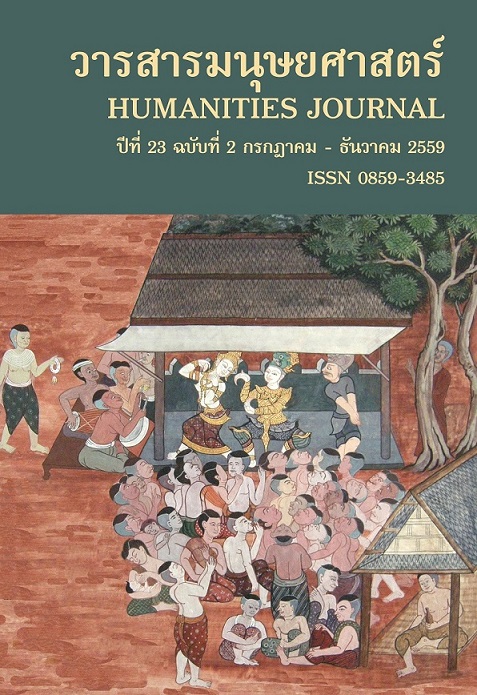วัฒนธรรมการบรรเลงดนตรีไทใหญ่ จังหวัดเชียงราย The Culture of Tai Yai’s Musical Performances in Chiang Rai Province
Main Article Content
Abstract
งานวิจัยเรื่องวัฒนธรรมการบรรเลงดนตรีไทใหญ่ จังหวัดเชียงราย มีวัตถุประสงค์ เพื่อศึกษาการบรรเลงดนตรีไทใหญ่ที่ปรากฏในจังหวัดเชียงรายและรวบรวมทำนองเพลง ผลการวิจัยพบการบรรเลงดนตรีไทใหญ่ที่สำคัญ 3 ประเภทคือ การตีกลองก้นยาว การตีกลองมองเซิงและการบรรเลงดนตรีจ้าดไต
การตีกลองก้นยาวในจังหวัดเชียงรายเป็นพื้นที่เดียวที่พบการฟ้อนนกพร้อมกับการฟ้อนโตและจบการบรรเลงด้วยการตีเปิดเสียง หรือ “เสียงเปิ้ง” เกือบทั้งพื้นที่ ซึ่งแตกต่างจากจังหวัดเชียงใหม่และแม่ฮ่องสอนที่จบด้วยการตีหยุดเสียงหรือเสียงปิด การตีกลองก้นยาวประกอบการฟ้อนนกมักขึ้นต้นด้วยการตีพยางค์เสียงถี่ รูปแบบทำนองปรากฏ 5 รูปแบบ พบการใช้ทำนองกลองที่ไม่ซับซ้อน ไม่หลากหลาย ไม่พบการตัดทอนกระสวนทำนองกลอง การตีกลองก้นยาวประกอบการฟ้อนโตจะเน้นการตีกดเสียงและตีไปตามการขยับตัวของผู้แสดง การตีกลองก้นยาวประกอบการฟ้อนดาบและฟ้อนมือปรากฏการทอนทำนองกลอง การตีกลองก้นยาวประกอบการแห่สามารถตีได้หลากหลายรูปแบบ
การตีกลองมองเซิงประกอบการฟ้อนปรากฏทั้งการนำกลอง ฉาบ และมอง (หรือโหม่ง) มาร่วมกันบรรเลงเป็นจังหวะฟ้อน “แช่-แช่-มง” และการนำเฉพาะฉาบและมองตีร่วมกันเป็นทำนองดังกล่าว
วงดนตรีจ้าดไตประกอบด้วย ปาตยา กลองสั้น และฮอก บรรเลงประกอบ การแสดงเรื่องราวที่ทำหน้าที่สอนเยาวชนและคนในสังคมไทใหญ่ให้เป็นคนดี ทำนองจ้าดไตปรากฏ 3 รูปแบบ ได้แก่ การด้นทำนองไปตามคำร้อง การร้องแล้วรับด้วยดนตรีและทำนองรำวงที่เล่นวนไปมา เสียงที่นำมาเรียงร้อยเป็นทำนองเพลงปรากฏการใช้ครบ 7 เสียง การกำหนดเสียงลูกตกหรือเสียงหลัก เสียงที่พบว่าใช้มากที่สุด ได้แก่ เสียงเร และ เสียงที่ใช้รองลงมาคือเสียงโด
This research, “The Culture of Tai Yai Musical Performances in Chiang Rai Province,” aimed to study Tai Yai musical performances in Chiang Rai Province and to collect their melodies. The study has found that there are three important types of Tai Yai musical performance-playing the Klong Kon Yao drums, playing the Mong Seng drums and the performance of the Chad Tai musical group.
Chiang Rai Province is the only place where Klong Kon Yao are played to accompany the Bird and the Tho dances. In almost all places in this province, the drum beats end with a beat to open up the sounds, known as “Sieng Poeng,” which are different from drum beats in Chiang Mai and Mae Hong Sorn Provinces, which end with a beat to stop or close up the sound. The playing of Klong Kon Yao to accompany the Bird dance usually begins with the beating of high frequency syllables. There are five melody patterns. These are not complex and do not vary and no reduction in the series of melodies for the drums has been found. The playing of the Klong Kon Yao to accompany the Tho dance focuses on the beat to press the sound and the rhythm reflecting the movement of the dancers. When playing the drums to accompany the Sword dance and the Hand dance, there is a reduction in the drum melody and the playing of the drums in a procession can be done in several forms.
The drums, cymbals and gongs (or Mong) are played along with the Mong Soeng drums to accompany dances and to create the “Chae-Chae-Mong” rhythm for the dance. When the cymbals and the gongs are played together, they emphasize this kind of rhythm.
The Chad Tai musical group, consisting of the Pataya (horizontal xylophone), the short drum and the Hog (a type of wooden clapper), plays to accompany the performance of stories that teach children and members of Tai Yai society to be good citizens. The melodies of this kind of musical group come in three forms-playing the music to accompany the lyrics, singing a song that concludes with music and playing Ram Wong melodies in a repetitive manner. All seven musical notes are used to create the melodies and it has been found that Re is the most used musical note followed by Doe.


